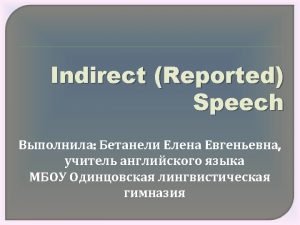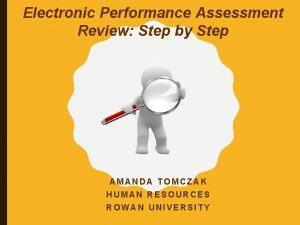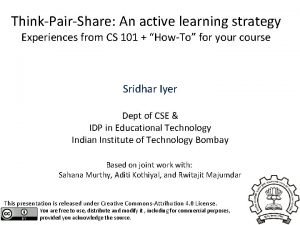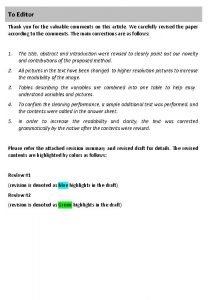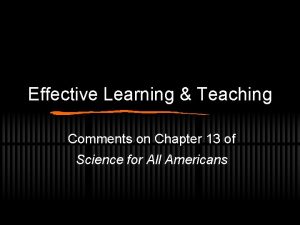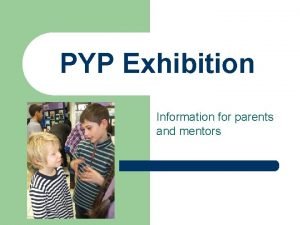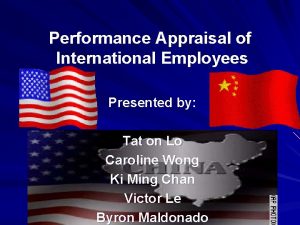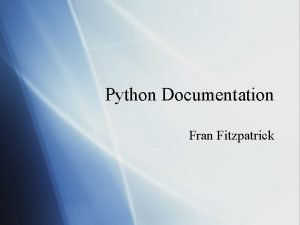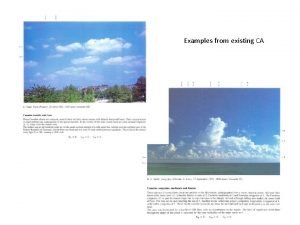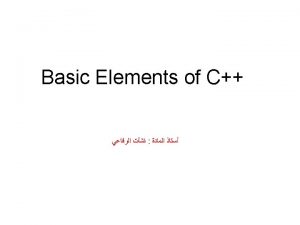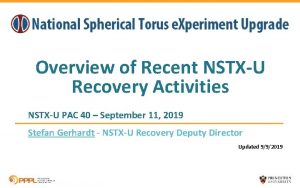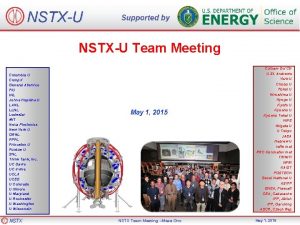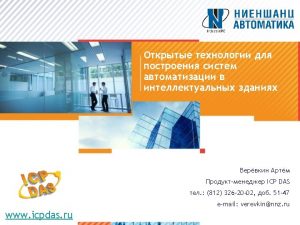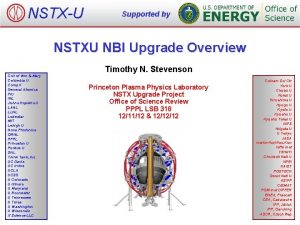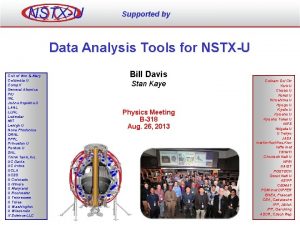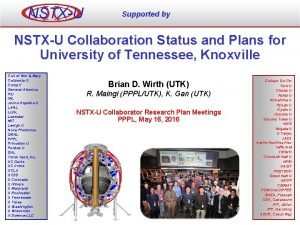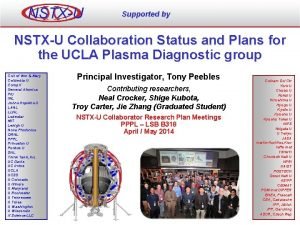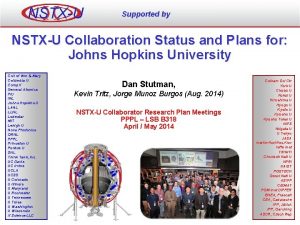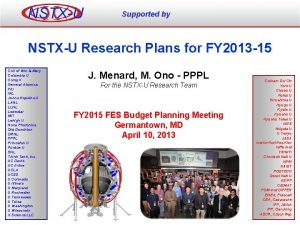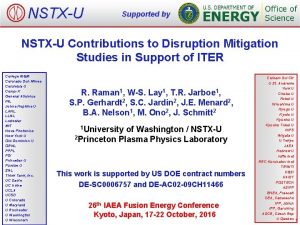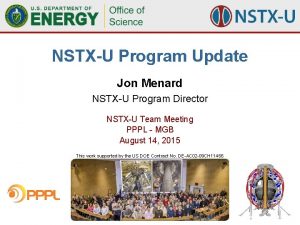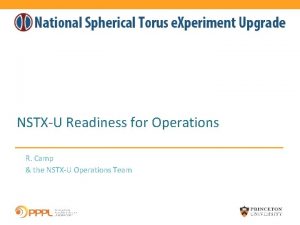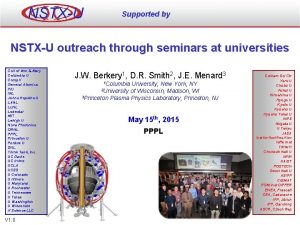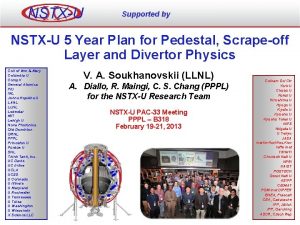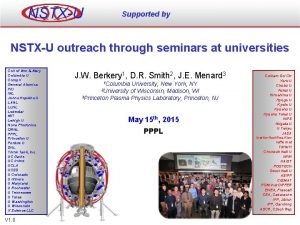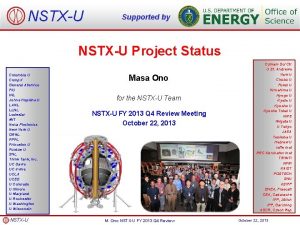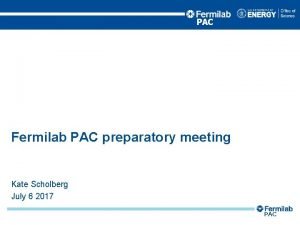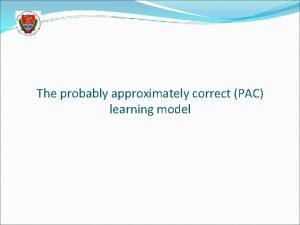General Comments The PAC congratulates the NSTXU team


































- Slides: 34

General Comments • The PAC congratulates the NSTX-U team for preparing a 5 year plan that is compelling in its opportunities for making important contributions to fusion plasma science, informs the development of the ST configuration, and contributes to the development of ITER • The PAC is pleased to hear that the Upgrade is on schedule and that there are no major technical issues that impede the completion of the project. We hope the budget permits completion of the upgrade in the Fall of 2014, since this is technically feasible. • The PAC sees excellent ongoing progress in analysis of key scientific issues, such as particle and heat flux control, that increase the plausibility for success in the scientific research plan and methods proposed for NSTX-U • The NSTX-U team remains scientifically productive, through ongoing analysis of NSTX data, collaborations with other programs, and participation in major scientific meetings and activities like ITPA

Comments on 1 st Charge Question 1. Assess the NSTX-U 5 year plan with respect to how well it addresses the key physics issues needed to evaluate the potential of the ST to provide highperformance plasmas for use in a future fusion research facility. Example future fusion research facilities include a toroidal plasma-material-interface facility, a fusion nuclear science facility, or a Pilot Plant/DEMO. • The NSTX-U research plan is clearly aimed to address the key scientific issues that define the potential of the ST • The PAC agrees with the assessment that NSTX-U, together with MAST-U and other facilities, provides the essential capabilities needed to address the most important scientific issues for the ST • The PAC agrees with the program’s highest priority goal to use the new capabilities made available in the upgrade (higher BT, IP, 2 nd NBI) to demonstrate high performance 100% non-inductive steady-state plasmas. The upgrade provides substantial new territory to explore, and NSTX-U will be among the world leaders in this area of research.

Comments on 1 st Charge Question (2) • Non-inductive startup – and especially ramp-up – is a recognized critical issue for the ST’s viability for future fusion applications (listed #1 in TAP for example): – The gap in demonstrating non-inductive startup/ramp-up is larger than the gap in demonstrating 100% non-inductive sustainment – The new capabilities in NSTX-U, most importantly the off-axis NBI, greatly improve the opportunity to demonstrate current ramp-up using NBI overdrive – The key physics of non-inductive ramp-up, such as energetic particle confinement, stability and transport, is particularly well aligned to the strengths of the NSTX-U research program in developing predictive science – While the PAC agrees that 100% non-inductive sustainment should be the highest priority, it is essential that non-inductive ramp-up be given more urgent emphasis (run time, manpower, diagnosis, etc). The ST’s viability is more uniquely connected to this scientific issue.

Comments on 1 st Charge Question (3) • The research plan calls for a staged approach in transitioning from a dominantly graphite wall to a full metal wall somewhere in the time frame 2019 -2023. Moreover the plan for using a mix of materials during the next five years will make it challenging to resolve the physics questions and issues associated with understanding the appropriate materials for an application like FNSF (for which graphite appears an unlikely solution) – Under the base funding scenario, the research plan emphasizes the physics enabled by the upgrade, in particular accessing lower collisionality. The PAC agrees with this strategy, and the program is constrained to implement a full metal wall in later years – Under the incremental funding scenario, a more aggressive approach toward the implementation of a full metal wall including the possibility of a flowing liquid metal module may be compatible with achieving other high level goals that are key to informing the ST’s readiness for next steps, including understanding material choices – The PAC recommends reconsidering such a strategy (with incremental funding), and perhaps replacing the present plan in the 5 year proposal with one along the lines described in Jon Menard’s answer to our question. At a minimum, we would like a more detailed report at the next PAC meeting.

Comments on 2 nd Charge Question 2. Assess the plans to investigate key tokamak physics issues for ITER. • The principal contributions to ITER lie in physics connections that inform operational scenarios on ITER. (The window for impact on ITER design is closing fast. ) • Important contributions for predictive physics understanding have been identified: – Rotation and mode locking – Disruption prediction, avoidance and mitigation – Vapor shielding during disruptions – ELM control using a variety of ITER-relevant tools – Mitigation of high heat flux through radiative diverter – Impurity transport – Energetic particle mode physics – High-harmonic fast-wave research • This work must be done in collaboration with other experiments, e. g. , through ITPA

Comments on 3 rd Charge Question 3. Assess plans to contribute to model validation and the development of predictive capability. • There are great examples of opportunities to develop predictive science through NSTX-U research. This was especially clear for energetic particle effects and turbulence and transport. However, the presentations are not uniform in exposing the scientific approach that was illustrated in Stan Kaye’s answer to our question on “best examples of advancing model validation and predictive capability. ” – Make sure opportunities are clear in the written proposal document – More coverage in the presentations would be helpful to expose the opportunities (with obvious risk for longer presentations!) • The PAC recommends including a presentation on theoretical connections to NSTX-U research to represent the balance of experiment, theory and modeling needed for developing predictive science.

Comments on 4 th Charge Question 4. Comment on possible improvements to the NSTX-U 5 year plan presentations including logic and format. • Three key additional capabilities (at least) are contingent on funding scenarios: cryo pump(s), 1 -2 MW ECH/EBW, full/partial NCC coil set. Most of the presentations appeared to assume the optimistic +10% funding scenario. It would be helpful to indicate what physics research will be accomplished with and without these additional capabilities, to more clearly expose the advantages they bring • The NCC coils offer great potential for investigating 3 D physics. The discussion of this capability was mostly confined to macro-stability. The PAC sees the NCC coils as a versatile tool with potential to investigate 3 D physics broadly. This is not fully apparent in the presentations. • The prospects for HHFW operation in NSTX-U appear greatly improved. Similar to the NCC coils, HHFW could be viewed as a more versatile tool for a variety of physics studies, including heating, rotation studies, and perhaps impurity control. • The presentation of plans for boundary physics studies and plasma-material interactions could be compressed

Material and PFC, Particle control

Charges #1, Assess the NSTX-U 5 year plan with respect to how well it addresses the key physics issues needed to evaluate the potential of the ST to provide highperformance plasmas for use in a future fusion research facility 1. At the end of this 5 year program, a compelling case for the first wall materials for an FNSF-ST will be difficult to make. Not enough will be known about operations with high-Z walls and the feasibility of Li coatings or flowing liquid Li walls (i. e. not the divertor) will still be in doubt or uncertain at best. 2. In the near-term, understanding of the fundamental physics and chemistry of (flowing) Li and Li coating should continue to be pursued if not accelerated with respect to flowing interfaces. a. The “uniqueness” aspect of NSTX-U claims that studies of liquid metals as advanced PFCs can be conducted under aggressive P/S scenarios. Bypassing the static Li module and moving straight to the flowing divertor module should be considered as a way to emphasize and take advantage of NSTX-U’s unique abilities. b. Strong potential for synergy with linear plasma devices and “table top” experiments to answer some of these questions re: Li and coatings and should be expanded as much as possible. What experiments can only be performed on NSTX-U? c. It is important to understand what role Li and Li coatings are playing in achieving various plasma operating regimes and conditions. What is possible in NSTX-U without the assistance of fresh Li coatings? This will be beneficial in the move towards more high-Z coverage and may be an important question to answer re: FNSF -ST

Charges #1, Assess the NSTX-U 5 year plan with respect to how well it addresses the key physics issues needed to evaluate the potential of the ST to provide highperformance plasmas for use in a future fusion research facility 3. Movement towards full high-Z coverage should be accelerated if possible (incremental funding) if the PFC question for a future ST is to be resolved on a reasonable time frame. a. Given there are no future plans to resolve the PFC question for ST on MAST-U, the burden falls to NSTX-U to make significant progress towards an answer. b. The near-term single row of high-Z material has limited but not negligible usefulness. A detailed experimental plan must be laid out with specific goals for the installation of this row and dedicated experimental time must be given to this experimental plan for the very first day this new row is installed. c. In the event that full high-Z coverage is not feasible in the 5 -yr plan, emphasis should be placed on work towards preparation for this transition, through linear devices and modeling as well as careful planning of the NSTX-U experiments towards this goal. 4. Particle control vs power control may demand different PMI/PFC strategies. Need to have more clear path on what specific role will lithium coatings play (e. g. as a “means to an end” for particle control vs. focused experiments on addressing the viability of liquid metals for power control)

Charge #2: Assess the plans to investigate key tokamak physics issues for ITER • • • Early installation of W tiles in the divertor (hopefully bulk tile) is expected to contribute to ITER/reactor issues. Active study of high-Z PFC and control for ITER should be required. Although a lot of PWI work such as erosion, deposition and melting dynamics has been done, control issue of high-Z accumulation by a variety of tools in NSTX-U (ECH, ICH, center NBI, gas puff/injection, etc. ) as well as development of the transport modeling will contribute to ITER physics and reactor operation. This knowledge base can also help accelerate implementation of more high-Z PFC coverage in NSTX-U. At the same time, introduction of Material probe (MAPP) is excellent for high-Z surface analysis without influence of discharge history. In investigating Li vapor shielding, it is important to keep the connection towards ITER-relevance. Efforts should be made to run experiments that make a close connection or simple extrapolation to ITER. Modeling will play a key role in strengthening this relevance so it must be closely integrated an perhaps even play a role in determining specific vapor shielding experiments to project towards ITER (This point also addresses charge #3).

Charge #3: Assess plans to contribute to mode validation and the development of predictive capability • Modeling in combination with these well controlled linear device or table top experiments is something that should be pursued more and can be pursued immediately before Upgrade is completed or any high-Z components installed in NSTX-U (as discussed in email chain) • Identify key model validation with laboratory experiments and in particular in the area of surface response codes (e. g. advanced dynamic BCA codes coupled to atomistic codes (e. g. quantum-classical molecular dynamics)) • Development of high-Z impurity transport modelling is important issue.

In addressing Charges #1 -3, comment in particular on the strength of planned NSTX-U contributions to boundary physics and plasmamaterial interaction (PMI) research • Particle control by repetitive Li injection and/or Li evaporation (LITERs) is a famous leading research of the NSTX project. More systematical evaluation is preferable to provide database for Li coating and LL divertor since hydrogen retention is largest unknown issue. At the same time, transport and PWI modeling of Li, mix-material (Li+C) and co-deposition should be developed. – Quantitative analysis (hydrogen isotope retention, mitigation of Li and mix-material layers) over the whole PFC surface contributes to future NSTX-U improvement – Existing and future particle balance results in the experiment discharges helps comparisons between Li and cryopump. – As for Li application to a larger device, evaluation of erosion rate (gross erosion) in experiments as a function of the plasma temperature and surface temperature is important database. It should be quantified and modeled. • Demonstration of Li vapor-shielding under high heat load is necessary before install into NSTX-U: – The performance of vapor-shielding is essential for application of Li target. Response of Li deposition against steady-state high heat flux and transient heat pulse should be investigated that the radiative cooling process of the LLD can be applicable to the experiments. – At the same time, compatibility of LLD with seeding impurity (recycling rate and sputtering rate) should be demonstrated. Research of He pumping scenario will be necessary for application to the reactor.

Boundary and PMI, Pedestal, SOL, divertor General remarks: • Planned program puts NSTX-U team in a strong position for boundary, pedestal, SOL and divertor physics research – High heat flux SF and SF-DN divertor research will be a world leader. – Ability to control pedestal structure using Li and SF divertor is an important tool to understand pedestal stability and transport. • New diagnostic capabilities will improve understanding. • Divertor physics is difficult to scale to larger devices. – Excellent diagnostics needed - Plans put NSTX-U team in strong position. – Existing models lack fundamental physics ⇒ New more complete models are needed, in particular to understand detachment (3 D, turbulence etc. ) • Turbulence codes may describe perpendicular transport, but lack geometry and parallel transport physics. • 2 D fluid codes describe parallel physics, but have wrong perpendicular transport model. 14

Boundary and PMI, Pedestal, SOL, divertor Assess the NSTX-U 5 year plan with respect to how well it addresses the key physics issues needed to evaluate the potential of the ST to provide high-performance plasmas for use in a future fusion research facility • 5 YP addresses many, but not all of the major issues for ST-FNSF and other future devices. – Heat flux mitigation via radiative or SF divertor or combination (incl. vapour shielding). – Particle control via cryo-pumping. • NSTX-U use of Li evaporation is most likely not a viable method for future devices (continuos operation, Tritium retention). – Pedestal physics with improved diagnostics and Li conditioning. • Unclear if turbulence diagnostics cover relevant region and have high enough resolution. • Will Li evaporation continue to suppress ELMs at higher Ploss? • but. . . – Choice of wall material not within 5 YP - how will the SOL/Pedestal change? • Liquid Li only after 2018 and in lower divertor - need to demonstrate DN capability. • Future devices will not work with C wall ⇒ Assessment of full metal wall too late. – Impurity retention and exhaust most likely not possible in open divertor - no plans for baffling. • Laser blow off may test high Z penetration. • Impurity seeded radiated divertor with long pulse capability will give indications. 15

Boundary and PMI, Pedestal, SOL, divertor Assess the plans to investigate key tokamak physics issues for ITER • NSTX-U capabilities will improve understanding of key ITER issues. – Pedestal transport and stability facilitated by recycling control via Li. – SOL turbulence (ballooning limit). – Test of theoretical models • Access to different parameter regime (e. g. trapped particle fraction in SOL, high heat flux through SOL). • Modelling needs to be supported by measurements (e. g. edge current density, Te/ne in SOL, Ti, SOL fluctuations). - is the SOL turbulence in NSTX-U electromagnetic? • Upgrade too late to inform on ITER design. • Unclear if ST regimes can be ported to conventional R/a devices. – Type-V ELMs only observed on NSTX. – Li evaporation may not be a viable technique in next step devices. • ELM mitigation techniques could be featured more prominently in 5 YP for ITER understanding - may be crucial to understand for FNSF as well. – Li granules injection - is it possible to test different materials on NSTX-U compatible with ITER/DEMO (Be, W, TESPEL. . . )? – 3 D perturbations. 16– Vertical kicks - how fast? compatible with SF-DN operation?

Boundary and PMI, Pedestal, SOL, divertor Assess plans to contribute to model validation and the development of predictive capability • NSTX-U team generally makes strong contribution, but more work is needed in particular with respect to pedestal and SOL turbulence. – Need to make sure good diagnostics in place. • The PAC notes some effort to compare data with existing theory, but more is needed – EPED comparison of pedestal profiles with data (Δp∝βθ) • Need to understand differences to other devices in particular MAST. – Comparison to XGC 1/XGC 0 is a beginning. • L-H transition via X-point transport needs direct confirmation (Er) • Only electrostatic (not suitable for pedestal, Ok for SOL). • Encourage closer comparison also with other codes. • NSTX-U plans to validate cryo-pump modelling within 5 YP - provides nice example for code validation. • More complete SOL and edge models need to be developed. – Push towards more complete modelling with extensive data. – Full f (Δf ? ) electromagnetic global gyrokinetics for pedestal. – SOL model with adequate parallel model and turbulent cross field transport needs development 17 and validation.

High-harmonic fast-wave and ECH/EBW (1) HHFW and ECH plans target NSTX-U research needs well: • • • HHFW planned for heating and bootstrap current generation during start-up, ramp -up, and H-mode sustainment: – Expect better HHFW coupling at higher BT of NSTX-U. – Higher Ip in NSTX-U should improve confinement of fast ions from NBI and limit interaction with HHFW antenna. Plans emphasize understanding antenna coupling and absorption of HHFW on thermal and beam ions, which are the most important physics issues for HHFW. 28 GHz ECH is planned to heat CHI-produced target plasmas: – Additional plans call for testing of EBW heating via the O-X-B conversion scheme in over-dense plasma.

High-harmonic fast-wave and ECH/EBW (2) Plans to contribute to model validation and predictive capability in this area should ensure success: • • Use of 3 D AORSA to study HHFW coupling and interactions of the HHFW with the SOL. Development and validation of finite ion orbit width corrections in CQL 3 D and benchmarking against FIDA diagnostic. Use of AORSA and TORIC to assess absorption of HHFW on thermal and beam ions. Testing of EBW heating via the O-X-B conversion scheme. – Detailed modeling, including SOL model and edge fluctuations.

High-harmonic fast-wave and ECH/EBW (3) Concerns and suggestions: • • Consider more detailed modeling of antenna structure in the SOL that employs 3 D solid geometry of antenna in contact with plasma (Microwave Studio, COMSOL, VORPAL). A concern that insufficient time will be spent to assess problems with coupling the HHFW into CHI produced plasmas and ramping plasmas – coupling could be difficult: – What will the balance be between HHFW/ECH/EBW/NBI in the scenario development and control program. – Need to insure that HHFW works with NBI in ramp-up scenarios. ECH / EBW could potentially be a game-changer for start-up because of ease of coupling and good size scaling PAC suggests further consideration to high field side launch for X-B conversion

Energetic Particles • The PAC encourages utilizing the control expertise on NSTX-U to demonstrate AE control: – Actuators include plasma shape, NBI and HHFW for density and current density profile control, and NCC fields to vary plasma and mode rotation. – In collaboration with theory, it would be valuable to develop a predictive capability for the stability of AE’s and then include this capability into the control system to learn how the navigate high performance regimes and avoid excessive fast ion loss due to AE’s. – Can a reduced model be developed to predict AE stability in real-time for event handling? • Second NBI line will open up new physics in AE stability area: – Second NBI could drive even more energetic particle modes and increase fast ion redistribution and losses, making AE stability and dynamics even more critical for NSTX-U than for NSTX. – Tangential geometry of second NBI also broadens the energetic particle profile, allowing greater profile control. – Additional control of the rotation profile with the NCC can also help control energetic particle modes.

Solenoid-free startup and ramp-up (1) • Non-inductive startup and ramp-up of plasma current is a unique and critically important issue facing next-step ST development. One of the high-level goals for NSTX-U is to develop and understand non-inductive start-up/ramp-up to project to ST-FNSF operation with small or no solenoid. • A clear scenario has been proposed: CHI is used as an initial current seed for subsequent current ramp-up to 1 MA using RF heating and NBI current over-drive. Local helicity injection is also being developed in collaboration with the PEGASUS group as an alternate method for the initial plasma current formation. • Very impressive progress has been made on the development of CHI, producing 200 k. A of plasma current in NSTX with the injector flux of ~ 50 m. Wb. The projected start-up current will be doubled with augmented tools available for NSTX -U.

Solenoid-free startup and ramp-up (2) • Significant progress has also been made on the modeling front: ü Modeling of the helicity injection startup in NSTX using the 3 D NIMROD code has shown promising results, now starting to show flux closure on experimental time scales. ü TSC simulation has demonstrated the possibility of ramping up the noninductive plasma current from the initial CHI target (400 k. A) to the desired goal (1 MA), with the proposed heating and current scenario aforementioned. • The PAC supports the plans of continuing MHD simulations of the start-up and ramp-up of CHI-started discharges in NSTX, further extending to NSTX upgrade and beyond. This will also very likely produce rich physics results on the dynamics of plasma relaxation, RF heating of low inductance CHI plasmas, as well as fast particle trapping and current drive during the current ramp-up process, which are unique to ST.

Solenoid-free startup and ramp-up (3) • The PAC is pleased by the progress in developing local helicity injection with retractable plasma guns in collaboration with PEGASUS and assessing the feasibility to scale it to NSTX-U. We support the plan to implement this on NSTX-U at the earliest possible date. • The PAC also applauds the ongoing collaboration efforts with QUEST in Japan in the development of metal electrode for CHI, to gain information for future use of metal divertor plate electrodes in NSTX-U. • However, the PAC is concerned by the level of effort on and resources allocated to this important area of research and development, which is a key component for developing ST toward FNSF and DEMO. • The PAC urges the NSTX-U team to establish more balance between noninductive start-up/ramp-up and non-inductive sustainment of high performance scenarios (see general comments).

Turbulence and Transport (1) Ø Comprehensive research program, identifies priorities to find ways to reach improved confinement regimes in future ST research facilities and their causes (the research plan presents a very valuable interaction between experiment and theory/modelling) Ø Emphasis to be given (and is given) to parameters which play a critical role in the projection (collisionality, beta, rotation) Ø Planned fluctuation diagnostics provide adequate coverage of both ion and electron scale spectral ranges, and electrostatic and electromagnetic turbulence. Suggest to assess concurrent applicability of different diagnostics in foreseen scenarios (radial coverage, simultaneous accessibility of plasma parameters) Ø Here, there are several research goals which are of common interest for both ST future research facilities and ITER (in particular, study of high beta turbulent regimes and comparison between STs and conventional aspect ratio tokamaks) 25

Turbulence and Transport (2) Ø Impurity transport recognized as critical issue in a device which exhibits dominantly ion neoclassical transport Ø In addition to the investigation of the dependence at lower collisionality, PAC suggests emphasis on investigation of the response of high-Z impurities to possible external means of control (e. g. with high-Z laser blow-off, impact of plasma rotation, and impact of HHFW, ECH/EBW if available later) Ø In practice, it is suggested to consider the preparation of operation with high-Z PFCs as an important scientific goal for impurity transport studies (and for transport studies in general) Ø Operational scenarios at low collisionality and reduced rotation (relevant for future research facilities) might exhibit increased role of turbulent transport on the ion channels Ø New research possibilities are offered by the 2 nd NBI for momentum transport. The PAC suggests emphasis on edge intrinsic torque (including 3 D effects), which play important role in determining rotation levels in future devices (important also in the prediction of operational scenarios in ITER) 26

Turbulence and Transport (3) Ø The PAC suggests to give comparable importance to both the establishment and the validation of reduced transport models, as well as to the application and validation of physics comprehensive and increasingly realistic theoretical models and codes Ø Particular emphasis to be given to the application of global codes (test importance of finite rhostar, global effects, e. g. also in momentum transport), e. g. , GTS and XGC 1 led by PPPL Ø Emphasis should also be given to the impact of rotation on various ES and EM turbulence regimes, impact of beta (electromagnetic effects), and plasma shape, which are all critical in STs, and extend knowledge with respect to conventional aspect ratio tokamaks 27

Scenarios and Control ASC Programmatic Goal For 5 Year Plan: Develop the basis for integrated, steady-state operation and axisymmetric control for next-step STs, while helping resolve key scenario and control issues for ITER ASC Operational Goal For 5 Year Plan: Establish stationary, 100% non-inductive operation, and partial inductive operation up to IP=2 MA, for 5 seconds over a wide range of Greenwald fractions • These are the correct goals, stated in the proper order – Establishes operating scenario for ST FNSF – defining role for NSTX – As a secondary (presumably lower priority) goal, helps to establish ITER operating point – NSTX is not unique, but can make important contributions

Scenarios and Control Thrust 1: Scenario Physics • • Findings – The scenarios chosen are appropriate and probably achievable with the inprogress upgrades, primarily the additional off-axis NBI – These scenarios do not make use of NSTX’s HHFW capabilities, which are not usually combined with NBI (due presumably to rf acceleration of beam ions? ) – It is not clear how or whether the impact of divertor conditions on core performance is considered – Access to the scenarios – in particular following a non-solenoidal current ramp – has not been addressed Recommendations – Evaluate and consider experimentally testing whether HHFW heating could provide useful additional flexibility in the scenarios that can be achieved – Investigate core-edge consistency in the context of these integrated scenarios – Plan for full discharge – including breakdown, ramp-up, flattop, and rampdown – ST FNSF scenario demonstrations, presumably late in the 5 -year proposal period

Scenarios and Control Thrust 2: Axisymmetric Control Development • • Findings – The NSTX Team is among the world leaders in development and exploitation of the Snowflake Divertor – The profile control work described in the proposal is not unique to NSTX, but NSTX can play an important part working with Lehigh (profile control) and DIIID (plasma control system and similar research lines) Recommendations – The PAC endorses the efforts here and the included collaborations

Scenarios and Control Thrust 3: Disruption Avoidance by Controlled Discharge Shutdown • • Findings – The NSTX Team’s work on disruption prediction is unique and world leading, but to date has only considered data from one device – Implementation in the NSTX PCS is the obvious next step Recommendations – In addition to obvious importance to NSTX-U, disruption prediction will have to work on ITER with little or no tuning. The next step for this approach should be to implement it for at least one other tokamak to determine how portable it is – The PAC endorses the approach being taken with respect to the NSTX research program

Scenarios and Control Thrust 4: Scenario Physics for Next Step Devices • • Findings – This appears to be an integration thrust combining elements of Thrusts 1 and 2 with an added emphasis on validated modeling Recommendations – Experiments done within the first two thrusts will provide opportunities to begin the model validation efforts inherent to Thrust 4. The NSTX Team should consider this in planning and carrying out those experiments.

Scenarios and Control Risk of early transition to high-Z PFCs We recognize that future devices are likely to operate with high-Z metallic walls, and the applicability of operating scenarios developed with carbon walls is under debate. That having been said… • Tokamak operating scenarios, particularly low density/high performance, are notoriously sensitive to wall conditions • Carbon PFCs are known to be forgiving • An early transition to high-Z PFCs would – Make scenario development more challenging – Disrupt progress in this area, possibly resulting in having to start over • Obvious tension with the need to establish the readiness of the ST for next step applications (see general comments)

Macro-stability and NCC • • • NSTX group has played leading role in mode control. The 5 YP leverages the existing expertise well and proposes a compelling program. The PAC is impressed by the disruption prediction system and encourages work on adapting it to other machines. The focus on NTV is understandable in view of the group’s leadership in this area, but seems to have all but driven out consideration of the role of resonant forces in phenomena such as locked modes and ELM control. Presentations emphasize mode-control aspects of NCC at the expense of edge/SOL physics. – ELM suppression: need ballooning mode analysis of perturbed equilibria to understand pacing – Interaction of NCC with “snowflake” divertor – Effect of Li on NCC ELM pacing – Effect of NCC on HHFW coupling NSTX has unique capabilities and leverage to help resolve basic physics of edge 3 D shaping. The 5 YP could be improved with respect to how it communicates the breadth of the NCC program.
 General remark
General remark Bureaucratic bypass syndrome
Bureaucratic bypass syndrome Team spirit becomes team infatuation
Team spirit becomes team infatuation The white team cheers for the blue team, just like
The white team cheers for the blue team, just like Coaching review comments
Coaching review comments Ratee comments sample
Ratee comments sample Derogatory comments examples
Derogatory comments examples Npqml final assessment examples 2019
Npqml final assessment examples 2019 Reviewer comments
Reviewer comments Myp report card
Myp report card Housekeeping items meeting
Housekeeping items meeting Sample observation comments for teachers
Sample observation comments for teachers Thank you for valuable comments
Thank you for valuable comments Additional comments uc application
Additional comments uc application What went well comments
What went well comments The hunger games chapter 20
The hunger games chapter 20 Growing success grade chart
Growing success grade chart Comments for chapter 13
Comments for chapter 13 Collegial approach
Collegial approach Form tutor report comments
Form tutor report comments Npqh task 2
Npqh task 2 Pyp exhibition examples
Pyp exhibition examples Reviewer comments
Reviewer comments Tat in appraisal comments
Tat in appraisal comments Pydoc comments
Pydoc comments Imargey
Imargey Earned value management systems application guide
Earned value management systems application guide C++ style comments
C++ style comments Comments and suggestions for teachers observation
Comments and suggestions for teachers observation Commentswrite a comment…
Commentswrite a comment… Term 2 religion comments
Term 2 religion comments Standard comments
Standard comments Ahrc grading scale
Ahrc grading scale Integrity appraisal comments
Integrity appraisal comments Which of the following is not valid is pl/sql *
Which of the following is not valid is pl/sql *
